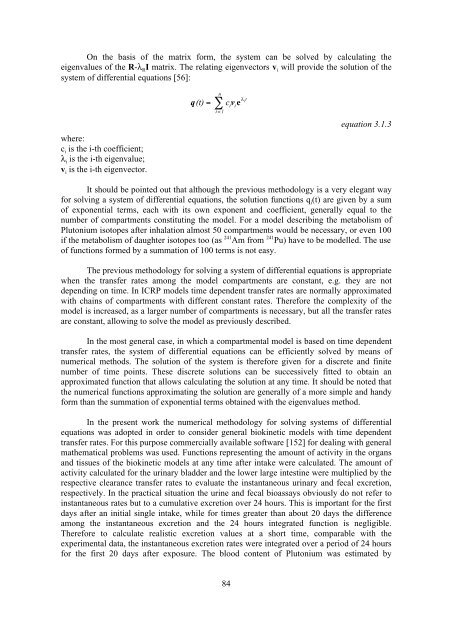Plutonium Biokinetics in Human Body A. Luciani - Kit-Bibliothek - FZK
Plutonium Biokinetics in Human Body A. Luciani - Kit-Bibliothek - FZK
Plutonium Biokinetics in Human Body A. Luciani - Kit-Bibliothek - FZK
You also want an ePaper? Increase the reach of your titles
YUMPU automatically turns print PDFs into web optimized ePapers that Google loves.
On the basis of the matrix form, the system can be solved by calculat<strong>in</strong>g the<br />
eigenvalues of the R-λ RI matrix. The relat<strong>in</strong>g eigenvectors v i will provide the solution of the<br />
system of differential equations [56]:<br />
where:<br />
c i is the i-th coefficient;<br />
λ i is the i-th eigenvalue;<br />
v i is the i-th eigenvector.<br />
n<br />
q(t) c i<br />
i 1<br />
84<br />
v ie λ i t<br />
equation 3.1.3<br />
It should be po<strong>in</strong>ted out that although the previous methodology is a very elegant way<br />
for solv<strong>in</strong>g a system of differential equations, the solution functions q i(t) are given by a sum<br />
of exponential terms, each with its own exponent and coefficient, generally equal to the<br />
number of compartments constitut<strong>in</strong>g the model. For a model describ<strong>in</strong>g the metabolism of<br />
<strong>Plutonium</strong> isotopes after <strong>in</strong>halation almost 50 compartments would be necessary, or even 100<br />
if the metabolism of daughter isotopes too (as 241 Am from 241 Pu) have to be modelled. The use<br />
of functions formed by a summation of 100 terms is not easy.<br />
The previous methodology for solv<strong>in</strong>g a system of differential equations is appropriate<br />
when the transfer rates among the model compartments are constant, e.g. they are not<br />
depend<strong>in</strong>g on time. In ICRP models time dependent transfer rates are normally approximated<br />
with cha<strong>in</strong>s of compartments with different constant rates. Therefore the complexity of the<br />
model is <strong>in</strong>creased, as a larger number of compartments is necessary, but all the transfer rates<br />
are constant, allow<strong>in</strong>g to solve the model as previously described.<br />
In the most general case, <strong>in</strong> which a compartmental model is based on time dependent<br />
transfer rates, the system of differential equations can be efficiently solved by means of<br />
numerical methods. The solution of the system is therefore given for a discrete and f<strong>in</strong>ite<br />
number of time po<strong>in</strong>ts. These discrete solutions can be successively fitted to obta<strong>in</strong> an<br />
approximated function that allows calculat<strong>in</strong>g the solution at any time. It should be noted that<br />
the numerical functions approximat<strong>in</strong>g the solution are generally of a more simple and handy<br />
form than the summation of exponential terms obta<strong>in</strong>ed with the eigenvalues method.<br />
In the present work the numerical methodology for solv<strong>in</strong>g systems of differential<br />
equations was adopted <strong>in</strong> order to consider general biok<strong>in</strong>etic models with time dependent<br />
transfer rates. For this purpose commercially available software [152] for deal<strong>in</strong>g with general<br />
mathematical problems was used. Functions represent<strong>in</strong>g the amount of activity <strong>in</strong> the organs<br />
and tissues of the biok<strong>in</strong>etic models at any time after <strong>in</strong>take were calculated. The amount of<br />
activity calculated for the ur<strong>in</strong>ary bladder and the lower large <strong>in</strong>test<strong>in</strong>e were multiplied by the<br />
respective clearance transfer rates to evaluate the <strong>in</strong>stantaneous ur<strong>in</strong>ary and fecal excretion,<br />
respectively. In the practical situation the ur<strong>in</strong>e and fecal bioassays obviously do not refer to<br />
<strong>in</strong>stantaneous rates but to a cumulative excretion over 24 hours. This is important for the first<br />
days after an <strong>in</strong>itial s<strong>in</strong>gle <strong>in</strong>take, while for times greater than about 20 days the difference<br />
among the <strong>in</strong>stantaneous excretion and the 24 hours <strong>in</strong>tegrated function is negligible.<br />
Therefore to calculate realistic excretion values at a short time, comparable with the<br />
experimental data, the <strong>in</strong>stantaneous excretion rates were <strong>in</strong>tegrated over a period of 24 hours<br />
for the first 20 days after exposure. The blood content of <strong>Plutonium</strong> was estimated by












![{A1[]Sp - Bibliothek](https://img.yumpu.com/21908054/1/184x260/a1sp-bibliothek.jpg?quality=85)




